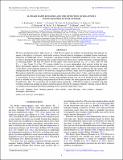M-DWARF RAPID ROTATORS AND THE DETECTION OF RELATIVELY YOUNG MULTIPLE M-STAR SYSTEMS
Author(s)
Swift, J.; Barclay, Thomas; Still, M.; Handler, G.; Muirhead, Philip S.; Huber, Daniel; Vida, K.; Joss, Matthew Albert Henry; Sanchis Ojeda, Roberto; Olah, K.; Rappaport, Saul A; Levine, Alan M; ... Show more Show less
DownloadRappaport-2014-M-DWARF RAPID ROTATO.pdf (2.676Mb)
PUBLISHER_POLICY
Publisher Policy
Article is made available in accordance with the publisher's policy and may be subject to US copyright law. Please refer to the publisher's site for terms of use.
Terms of use
Metadata
Show full item recordAbstract
We have searched the Kepler light curves of ~3900 M-star targets for evidence of periodicities that indicate, by means of the effects of starspots, rapid stellar rotation. Several analysis techniques, including Fourier transforms, inspection of folded light curves, "sonograms," and phase tracking of individual modulation cycles, were applied in order to distinguish the periodicities due to rapid rotation from those due to stellar pulsations, eclipsing binaries, or transiting planets. We find 178 Kepler M-star targets with rotation periods, P [subscript rot], of <2 days, and 110 with P [subscript rot] < 1 day. Some 30 of the 178 systems exhibit two or more independent short periods within the same Kepler photometric aperture, while several have 3 or more short periods. Adaptive optics imaging and modeling of the Kepler pixel response function for a subset of our sample support the conclusion that the targets with multiple periods are highly likely to be relatively young physical binary, triple, and even quadruple M star systems. We explore in detail the one object with four incommensurate periods all less than 1.2 days, and show that two of the periods arise from one of a close pair of stars, while the other two arise from the second star, which itself is probably a visual binary. If most of these M-star systems with multiple periods turn out to be bound M stars, this could prove a valuable way discovering young hierarchical M-star systems; the same approach may also be applicable to G and K stars. The ~5% occurrence rate of rapid rotation among the ~3900 M star targets is consistent with spin evolution models that include an initial contraction phase followed by magnetic braking, wherein a typical M star can spend several hundred Myr before spinning down to periods longer than 2 days.
Date issued
2014-05Department
Massachusetts Institute of Technology. Department of Earth, Atmospheric, and Planetary Sciences; Massachusetts Institute of Technology. Department of Physics; MIT Kavli Institute for Astrophysics and Space ResearchJournal
The Astrophysical Journal
Publisher
IOP Publishing
Citation
Rappaport, S., J. Swift, A. Levine, M. Joss, R. Sanchis-Ojeda, T. Barclay, M. Still, et al. “M-DWARF RAPID ROTATORS AND THE DETECTION OF RELATIVELY YOUNG MULTIPLE M-STAR SYSTEMS.” The Astrophysical Journal 788, no. 2 (May 29, 2014): 114. © 2014 The American Astronomical Society
Version: Final published version
ISSN
0004-637X
1538-4357